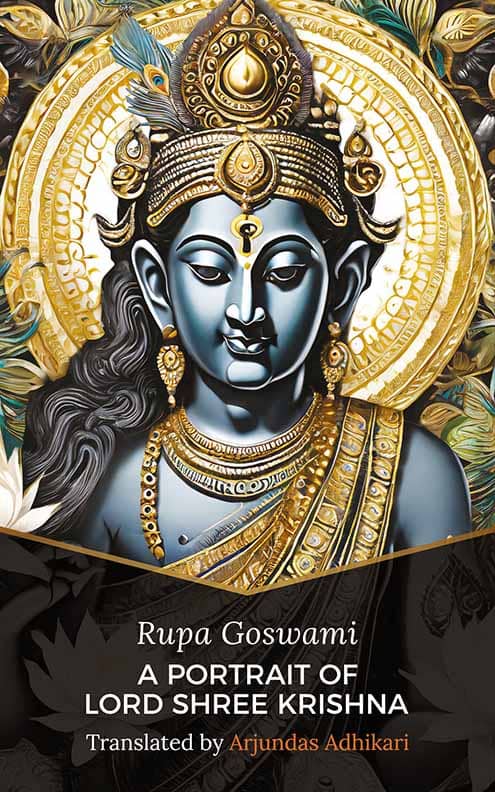
Inasmuch as a little knowledge of British history comes in handy for an audience of a Shakespeare history play like Henry IV part 2, etc. contextual information is similarly vital for the full appreciation of a play that seriously deals with the subject of the pastimes of Lord Shree Krishna. It benefits an audience of a Sanskrit drama such as Vidagdha Madhava (aka A Portrait of Lord Shree Krishna) by Rupa Goswami (translated into English by Arjundas Adhikari) to be au fait with how Krishna is perceived in Hinduism (for want of a better term) as supernal in nature, and also the position He holds in the extensive pantheon of Hindu culture’s favourite supernals.
In broad terms, the famous Upanishads (qv) of the Vedas (Sanskrit scriptures) expound on the general attributes of Truth which all human beings are supposed to seek, if they are not already seeking. One pre-eminent stanza from the Shvetashvatar Upanishad stands apart:
na tasya karyam karanam ca vidyate
na tat samas cabhyadhikas ca drishyate
Shvetashvatar Upanishad 6.8
The second line here ascertains that Truth, (aka brahman, param satyam, para-gati etc.) cannot be measured up against anything, reason being that Absolute Truth is incomparable. The adjective abhyadhika (above) implies ‘something superior to (something else).’ The word preceding it: na, stands for ‘not.’ So, the second line conveys the same idea propounded by many religions talking about God, namely that nothing is equal to (na tat samas) or superior to (na abhyadhika) God. The meaning of the name ‘Allah’, for example, gives the same sense.
The implication of the first line of the above verse from the Shvetashvatar Upanishad is especially interesting because it alludes to the nature of Krishna as elaborated upon in Rupa Goswami’s spiritual drama, A Portrait of Lord Shree Krishna (aka Vidagdha Madhava). How does this description of the Shvetashvatar Upanishad’s Absolute Truth allude to Krishna? We may reasonably assume so because the author of the entire Vedic canon (Vyasadev) confirms it, and so do the various sages whose teachings contribute to the Vedas, for example, Narada, Asita, Devala etc. Furthermore, Krishna is recorded as attesting to this Himself in the famous Bhagavad Gita. And what exactly is the important attribute of the Absolute Truth given in this Shvetashvatar Upanishad in question? It is that the Absolute Truth, whilst great, is great to the extent of having no obligation to do anything – no duty, no task, job, business or enterprise – nothing whatsoever has been assigned as the remit of the Absolute Truth. Sweet will rules.
If the Absolute (Krishna) has nothing to do, what is His disposition? And the answer is that as the Supreme Person (param purusha) He is always blissfully reciprocating in whatever manner of relationship those who love Him would have Him reciprocate (anandamaya ‘bhyasat). Thus, He is loved as master, friend, son or lover. And these relationships are played out on earth in the realm of Vrindavan forest and the famous village of cowherds known as Vraja or Gokool, and recently made available to one and all through Rupa Goswami’s remarkable spiritual drama Vidagdha Madhava aka A Portrait of Lord Shree Krishna. Contextually, we can understand that A Portrait of Lord Shree Krishna represents a highly confidential appreciation of the Absolute Truth.
Arjundas Adhikari
Nb. Regarding Krishna’s position in the hierarchy of the Hindu pantheon, it may also be noted that the same Shvetashvatar Upanishad identifies Absolute Truth as being ‘God of all gods’:
tam devatanam paramam ca daivatam
Shvetashvatar Upanishad 6.7

